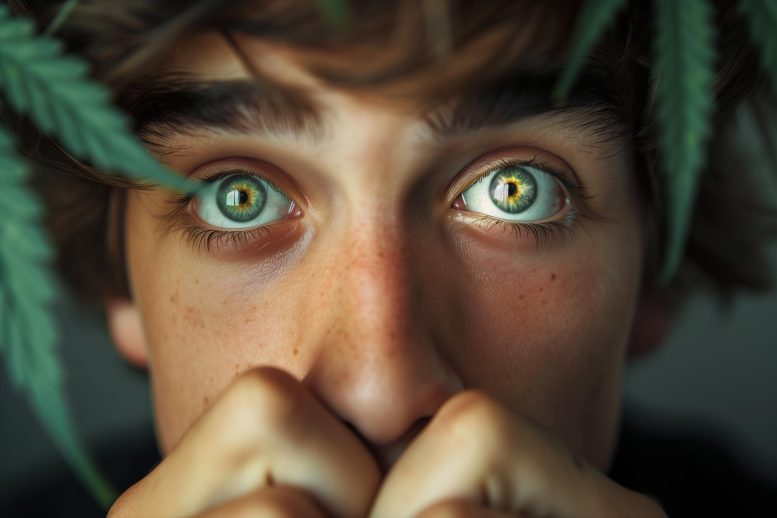
Young people using high-potency cannabis face double the risk of psychosis compared to those using lower-potency varieties, according to a University of Bath study. This research highlights the need for better data on long-term effects and improved public health messaging. Credit: SciTechDaily.com
A new study indicates that high-potency cannabis use between the ages of 16 and 18 doubles the risk of psychotic experiences from 19-24, compared to lower-potency use in young adults.
Young people consuming higher-potency cannabis, such as skunk, between the ages of 16 and 18, are twice as likely to have psychotic experiences from age 19 to 24 compared to those using lower-potency cannabis. That’s according to a new University of Bath study published in the scientific journal, Addiction on May 13.
Previous studies from the Addiction and Mental Health Group at the University of Bath have found that the concentration of THC in cannabis – the main psychoactive component of cannabis — has increased by 14% from 1970 to 2017, meaning today the UK cannabis market is dominated by high-potency cannabis varieties like skunk.
This new study is the first longitudinal examination of early adolescent psychosis measures and detailed cannabis potency.
This data stems from the Children of the 90s study, the most comprehensive research project of its kind. It commenced in Bristol over 30 years ago, gathering information and data from thousands of families across the city.
Nearly 14,000 individuals were recruited into the study from birth, many of whom continue to take part in the study to the present day. At ages 16 to 18, participants were asked about recent cannabis use. By age 24, they disclosed their primary cannabis type and any experiences of psychotic experiences such as hallucinations or delusions.
Lead author, Dr. Lindsey Hines from the University of Bath Department of Psychology said: “Young people using higher-potency forms of cannabis are twice as likely to have experiences associated with psychosis, such as hallucinations and delusions. Importantly, the young people we asked had not previously reported these experiences before starting their cannabis use. This adds to the evidence that use of higher-potency cannabis may negatively impact mental health.”
This study adds to a wealth of research stemming from the ALSPAC study, which examines various topics from links between medication taken while pregnant and a child’s well-being, to the way social media can lead to self-harm.
Key Findings from this study:
- 6.4% of young people using cannabis had new psychotic experiences, compared to 3.8% of non-users
- After starting to use cannabis, 10.1% of young people using higher-potency cannabis reported new psychotic experiences, compared to 3.8% using lower-potency.
- Those using higher-potency cannabis were more than twice as likely to report new psychotic experiences after starting to use cannabis, compared to those using lower-potency cannabis.
This research adds to the growing body of evidence indicating that high-potency cannabis use is associated with an increased likelihood, and now incidence, of psychotic experiences.
The researchers are now calling for better evidence on the long-term outcomes of the use of higher-potency cannabis, and exploration of measures to reduce the potency of cannabis available to young people.
Dr. Hines said: ”Cannabis is changing and higher-potency cannabis is increasingly available. These findings show how important it is to understand the long-term effects of higher-potency use in young people. We need to improve messaging and information available to young people on the impacts of cannabis use in the 21st century.”
The study is published in the scientific journal, Addiction.
Reference: “Incident psychotic experiences following self-reported use of high-potency cannabis: Results from a longitudinal cohort study” by Lindsey A. Hines, Jon Heron and Stanley Zammit, 13 May 2024, Addiction.
DOI: 10.1111/add.16517
The study was funded by The Wellcome Trust.









More nonsense from the fake medical establishment. But, the covid vaccines are totally safe.
Nobody believes you fake liars anymore.
Its not the weed, its the pesticide, herbicide and fungicide which commercial growers use on your weed. They aren’t going to lose thousands of dollars on their crops just so you can have chemical free weed. They don’t care about you, just your money. Always grow your own. The dangers are much greater than psychosis.
Wait a minute-I had the 1978 High Times centerfold poster of all time, with the world’s 30 greatest varieties shown (including crystal leaf Maui), that were ever grown, including the perennials that grow in Tibet and Nepal and produce the pot for the NEVER sold pink hashish.
My all time fav is the non-hybrid Viet Namese indicus, that is purple and green, and looks like Brussels sprouts. You CAN make hash from that….medical is about the same potency as mexi dirt weed from 1979, that was $300/lb, just GTFOH with the “scary” weed. Where do I get that????
Loved those centerfolds, lol! When I was in the Army, I never made it to Amsterdam but moved to Europe in 1990 and have been twice! The first time was in 1995, took the centerfold from HighTimes of the “Cannabis Olympics” of all the winners which was the best of the best and made all the coffee shops that produced them and bought 1 gram each to take back to the country I am living in now, but, on the German Border, they were controlling, and since my car was covered in bird poop, they knew we have stayed at the camping place in Amsterdam and searched our car and found everything. Course, they only confiscated it, and said if I wanted to complain, then they would write out a report, otherwise I could leave, so I left! Best the SOB’s was smoking it themselves! FJB!
I have enjoyed cannabis for 54 years, 72 now, started in the Army when I was 17, but only smoked hash for three years before trying my first cannabis. We only had hash in Germany back in the late 60/early 70’s and never tried cannabis until I got back home to the USA three years later, and it was Mexican dirt week back then! Love the new and improved cannabis, but was raised in Oklahoma, where a joint was a five year prison sentence, way back when, but now it is legal and I am living in central Europe, where it is still Illegal! I can’t ever catch a break so it is a good thing I am also an expert grower! FJB!
Drunks run stop signs, pot heads just sit there waiting for it to turn green.
Be thankful if you don’t live in states like California and Colorado.
It doesn’t matter how extensive the research is, pot lovers will deny that it’s true. Politicians who want their votes will ignore any negative research on pot.
It’s a pointless fact and research based article, since people don’t want to hear it.